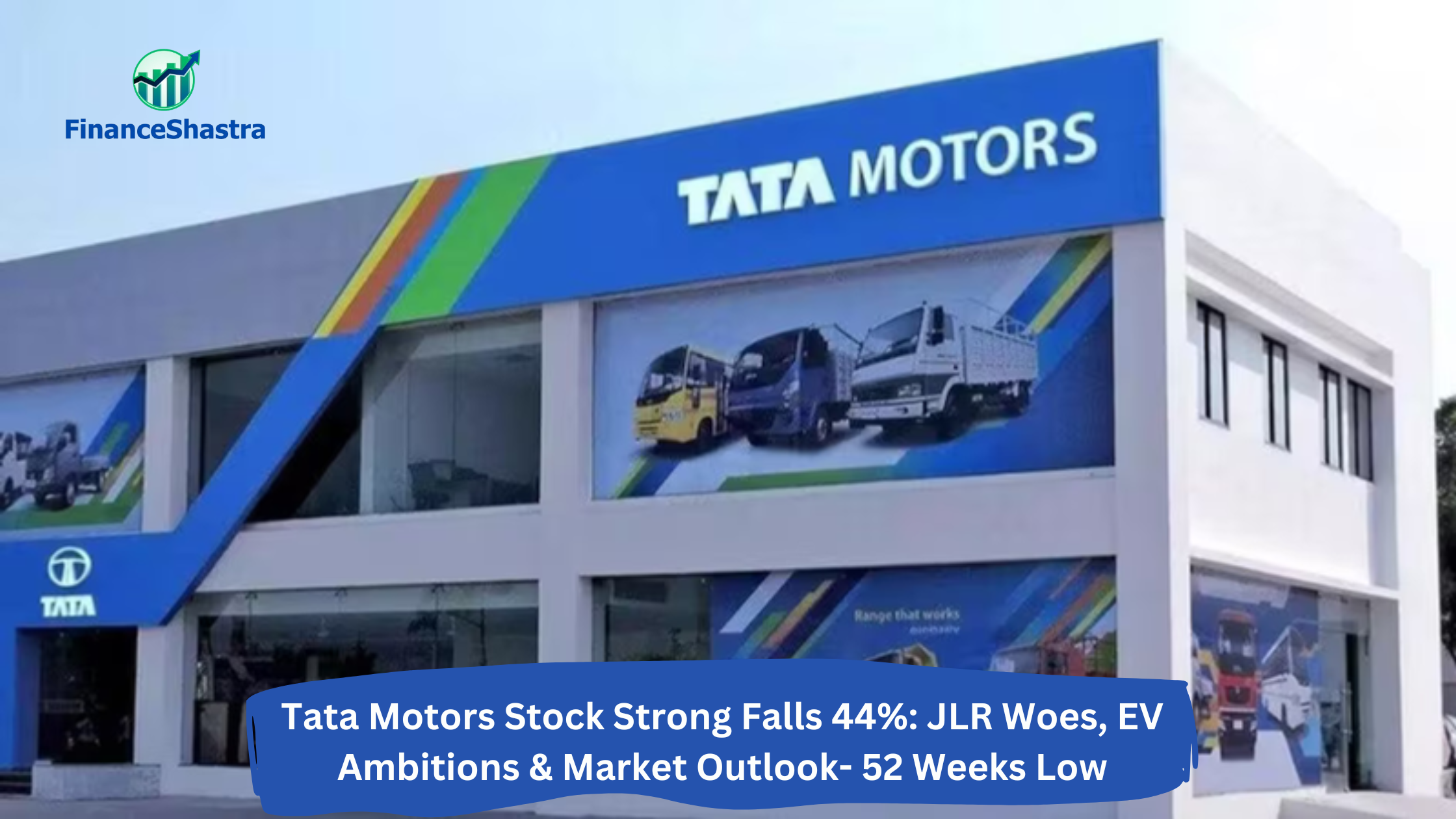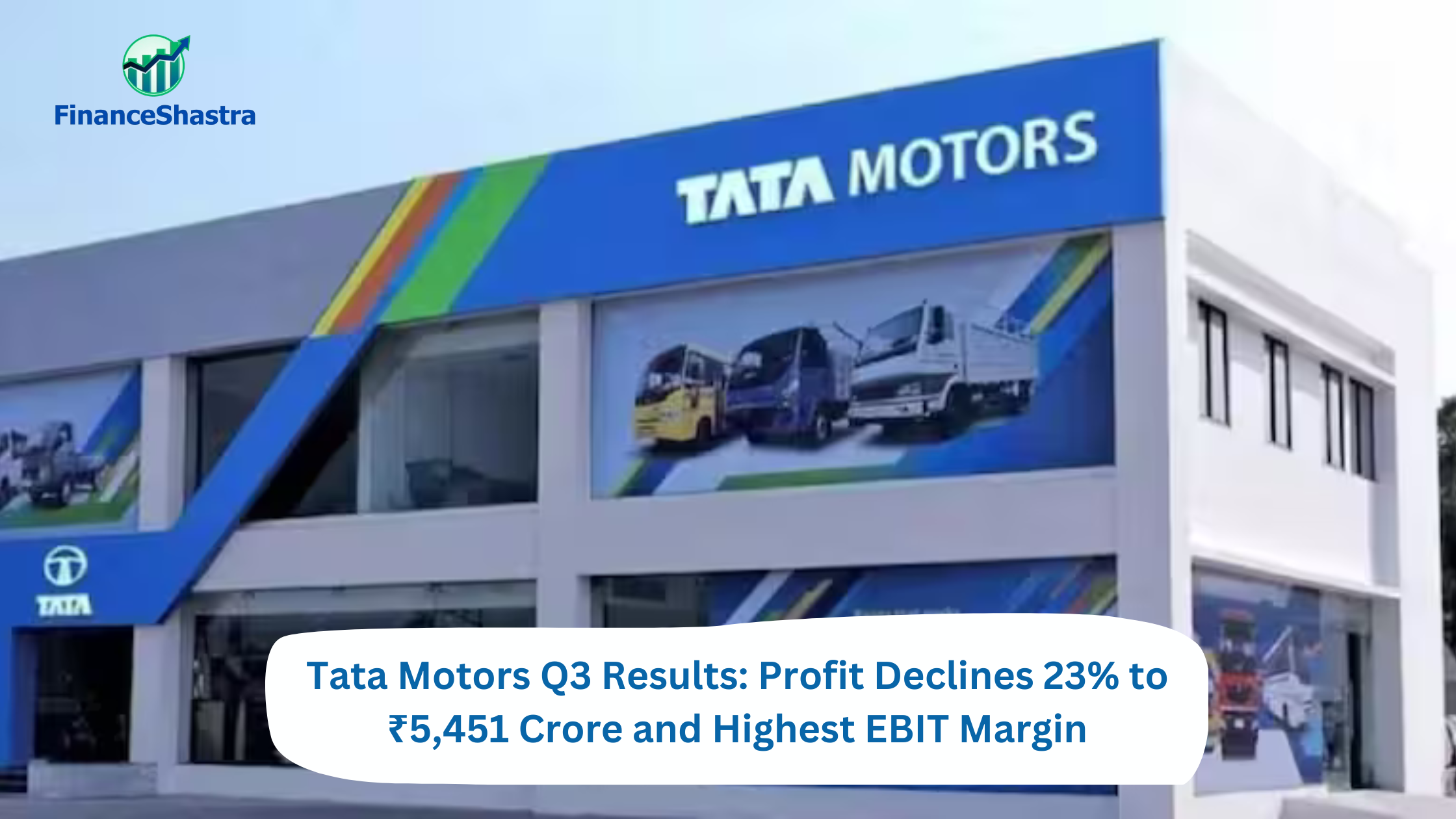Tata Motors Stock Strong Falls 44%: JLR Woes, EV Ambitions & Market Outlook- 52 Weeks Low
Business and Industry Overview:
Tata Motors started in 1945 as part of the Tata Group. It is one of the biggest car companies in the world and has about 81,090 employees. The company makes many types of vehicles, like cars, SUVs, trucks, buses, military vehicles, and electric cars. It has partnered with companies like Fiat and Marcopolo to grow worldwide. Tata Motors is in about 175 countries and has research centers in the UK, Italy, India, and South Korea. In January 2024, it sold 31,188 commercial vehicles.
Tata Motors has four main business areas. Jaguar Land Rover (JLR) is the biggest, making up 71% of its business in 9M FY25. JLR includes luxury cars and SUVs like Jaguar sedans, electric cars, and Land Rover off-road vehicles. Sales of key models like Range Rover, Defender, and Discovery dropped compared to last year. North America saw more sales (33% vs 26% in FY24), but sales fell slightly in Europe, the UK, and other regions. Tata Commercial Vehicles (17% of the business) is India’s largest truck and bus maker, but its market share fell to 37.7% from 41.7%. Bus sales grew, but truck and small cargo vehicle sales dropped. International sales were also lower. Tata Passenger Vehicles makes up 11% of the business. It is India’s third-largest car company, with a 13.3% market share. It also leads the electric vehicle (EV) market with a 53% share. The company launched new models of the Tiago, Tiago.ev, and Tigor in Q3 FY25. Total car sales, including EVs, increased. Tata Motors also offers vehicle loans, but this part of the business is smaller now, making up only 1% of revenue (down from 3% in FY22). Loan disbursements in FY24 were ₹17,884 Cr. The company has 25 factories across India, China, North America, Europe, and the UK. It spent ₹6,000 Cr on new projects in FY25, including a new factory in Tamil Nadu. R&D spending increased to 6.7% of revenue, focusing on safety tech and smart vehicles. It also filed 670 patents and 424 design applications. In March 2024, Tata Motors decided to split into two separate companies—one for Commercial Vehicles and another for Passenger Vehicles, including JLR and EVs. The split should be finished by October 2025.
The Indian automobile industry is very important for the country. It helps the economy grow and brings new technology. Most people in India use two-wheelers like bikes and scooters because they are cheaper and easy to use. Many companies are also selling vehicles in villages, which is helping the industry grow. Big trucks and buses are also in demand because more goods and people need to be transported. In the future, electric vehicles (EVs) will be more popular. Small cars and three-wheelers that run on electricity are becoming common. India makes a lot of big vehicles. It is the number one maker of tractors, number two in making buses, and number three in making heavy trucks. In 2023, India made about 26 million vehicles, and in September 2024, the country produced 2.77 million vehicles. The automobile industry adds about 7.1% to India’s total money (GDP) and gives jobs to about 19 million people. India also sells a lot of vehicles to other countries. The government is helping the industry grow with new policies and plans. The Indian car market was worth $32.7 billion in 2021 and is expected to grow to $54.84 billion by 2027. The global EV market was worth $250 billion in 2021 and will grow five times by 2028.
In the first half of 2025, India produced over 15.6 million vehicles. In 2024 (until January), India sold 1.3 million electric vehicles. By 2030, India’s EV market could be worth $206 billion, but it will need $180 billion in investments. The EV finance market will also grow to $50 billion by 2030. The EV battery market is also expected to grow very fast. India wants to sell five times more vehicles to other countries between 2016 and 2026.
Big companies are investing a lot of money in India. From 2000 to 2023, India got $35.65 billion from foreign investors. India could become the biggest EV market by 2030. Tata Motors, Renault-Nissan, and Hyundai are building new factories and investing billions of dollars in India. Other companies like Mercedes-Benz, Maruti Suzuki, Hero MotoCorp, and Ola Electric are also spending money to make more vehicles. The government is supporting this with new rules, allowing full foreign investment, and launching programs like PM E-DRIVE and the Electric Mobility Promotion Scheme.
Latest Stock News:
Tata Motors’ share price has gone down a lot. This is because people are worried that fewer people will buy Jaguar Land Rover (JLR) cars and Tata’s big trucks and buses next year. In July last year, the share price was ₹1,179, but now it has fallen 43% to ₹662. This happened because JLR cars may not sell well in big countries, and the US might add extra taxes on cars from Europe. Since JLR sells many cars in the US, this could be bad for Tata Motors. Some experts say this is a good time to buy the shares because the price may go up again. They believe the price could reach ₹850-₹900, but it may take more than a year. Tata Motors’ cars in India are still selling well, and the company is planning to become debt-free. A company called CLSA says Tata Motors’ shares are cheaper than they should be.
Tata Motors’ share price has been falling for a long time. It has dropped 44% from its highest price of ₹1,179 in July 2024. On February 25, the price went down to ₹662.10, the lowest in the past year.
One big reason for this fall is that Tata Motors’ profits in the last quarter were not good. Jaguar Land Rover (JLR), which makes a lot of money for the company, had lower profits. Sales in important places like China and Europe were also weak. Tata Motors’ total profit fell by 22% compared to last year. Its truck and bus sales in India also went down.
Potentials:
Tata Motors wants to make more electric cars in the future. The company plans to invest a lot of money to make electric cars popular. By 2030, it wants 20 out of every 100 cars it sells to be electric. By 2026, it will launch 10 new electric cars. It will also use sunlight and wind to make and charge these cars. Tata Motors wants to stop polluting the air. It aims to make passenger cars pollution-free by 2040 and trucks by 2045. The company is also working on using special fuels like hydrogen and biofuels for big vehicles. It plans to connect electric cars with solar panels on rooftops to save energy. In the next two years, Tata Motors will open more shops to sell electric cars in 50 cities. It will also make better electric cars that cost the same as petrol and diesel cars. By 2030, it wants half of its electric car owners to use solar energy at home. Tata Motors is also designing new cars. One example is the Avinya, a car that looks like a mix of an SUV, a hatchback, and a big family car.
Analyst Insights:
Tata Motors is a strong company with good financial numbers. Its total market value is ₹2,43,620.92 crore. The company’s P/E ratio is 7.65, which means its stock price is low compared to its earnings. It gives a dividend yield of 1.89%, meaning shareholders get some money back. Tata Motors earns good profits, with a Return on Capital (ROCE) of 20.11% and a Return on Equity (ROE) of 18.1%. The company also pays out 0.45 of its profit as dividends. The company has reduced its debt, which is a good sign. Over the last five years, it has grown its profit at a fast rate of 93.1% per year. However, its tax rate is low, which could be something to watch. Another concern is that the company’s promoters (main owners) have sold some of their shares in the last three years, reducing their stake by 3.83%.
Tata Motors is a strong company, but its stock price has dropped a lot recently. The company is making good profits and has reduced its debt. It is also investing ₹18,000 crore in electric cars and wants to capture 20% of the market by 2030. However, its luxury car brand, Jaguar Land Rover (JLR), is not doing well in some countries, and there is tough competition from Mahindra & Mahindra and Tesla. Despite these challenges, experts believe the stock will recover in the long run.However, short-term traders should be careful as the price may continue to fluctuate.


